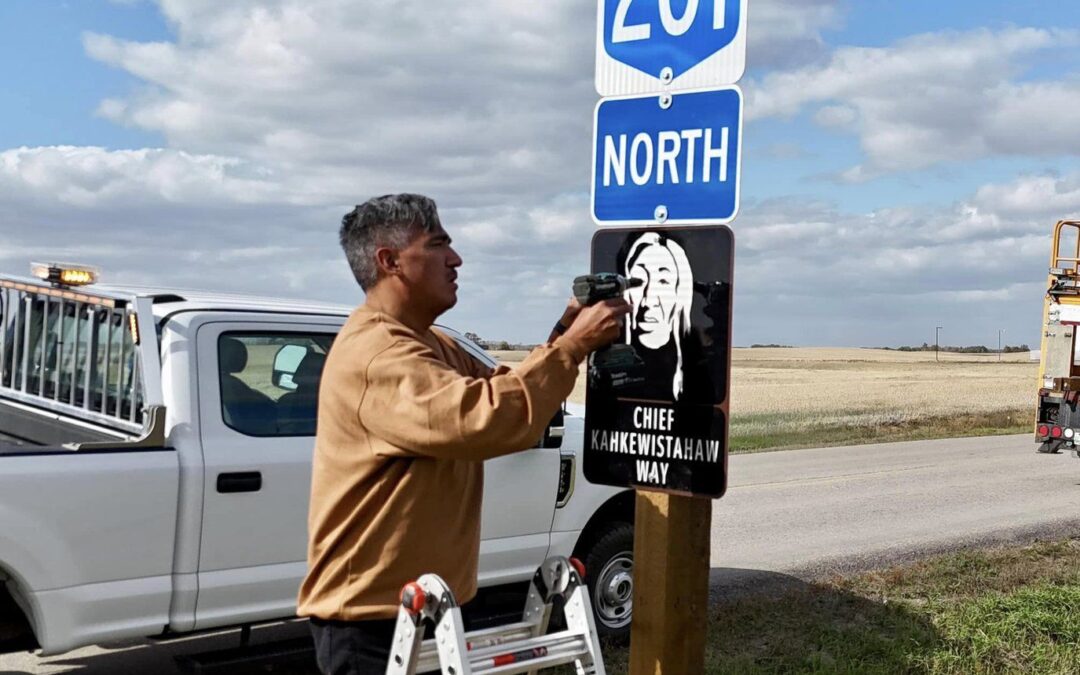By: Nicole Taylor, Local Journalism Initiative Reporter
Highway 201 between the Trans-Canada Highway and the Qu’Appelle Valley, partially running through Kahkewistahaw First Nation, has been officially designated Chief Kahkewistahaw Way, in honour of one of the original signers of Treaty 4.
The announcement was made by Moosomin-Montmartre MLA Kevin Weedmark during a community celebration attended by provincial representatives, local leaders, and members of Kahkewistahaw First Nation.
Chief Kahkewistahaw, who signed Treaty 4 on September 15, 1874, is remembered for his leadership during a time of significant change and negotiation between First Nations and the Crown.
“Chief Kahkewistahaw was a peacetime chief. He didn’t want to bring harm on anybody. He liked treating everyone in a good way, even non-Indigenous. He welcomed them with open arms,” said current Chief Evan Taypotat. “He was a man of communication in a time of turmoil. When he passed on in 1906, he left us a legacy to keep fulfilling, and here we are 118 years later, ensuring that he was not forgotten and that his legacy is still remembered.”
Chief Taypotat said the idea to rename the highway had been a long time coming. The proposal began nearly three years ago, after a drive through Whitecap Dakota Nation.
“I was driving south of Saskatoon on my way to a meeting and noticed that the road was called ‘Chief Whitecap Trail,’” said Chief Taypotat. “I thought to myself, if they could have the name of their highway changed, why couldn’t we?”
Chief Taypotat began making inquiries with his land department, and the process was initiated. “They came back saying to start at this email, and it just got rolling from there,” Taypotat said. “There was a bit of conversation back and forth, and about a year ago they agreed to it. At that point, it was about picking out logos and all that.”
A committee made up of representatives from Kahkewistahaw First Nation, the Town of Broadview, the Rural Municipality of Elcapo, and the Government of Saskatchewan unanimously supported the name change.
Kevin Weedmark, MLA for Moosomin–Moose Mountain, called the new designation a significant step toward recognition and reconciliation.
“This is more than just a change of signs along the roadside. This is a moment of recognition, respect, and reconciliation,” said Weedmark. “It is a step towards acknowledging the contributions, leadership, and enduring legacy of Chief Kahkewistahaw, a man whose vision and strength continue to inspire generations. This is the third highway in Saskatchewan to be renamed in honour of an Indigenous individual. Our province has also put up road signs designating the treaty areas. Every time I drive between Moosomin and Kahkewistahaw First Nation, I pass a boundary that tells me I am entering Treaty 4 territory, and that serves as a constant reminder that we are all treaty people.”
Chief Taypotat said many people did the work that led to the designation. “At times like this guys like me and Kevin get all the praise but at the end of the day it’s the people in the trenches doing the work and they need recognition as well..”
He said Chief Kahkewistahaw was a leader who chose peace during a difficult period. “In times when there was a lot of turmoil and resistance from the First Nations peoples of Canada, Chief Kahkewistahaw chose peace and not to fight against the settlers that came, and for this he was rewarded by the government,” said Taypotat.
“He was taken to Ottawa and introduced to the man who was helping the settlers thrive in Canada. That’s just who he was. We get a lot of people that go down to Round Lake and Crooked Lake driving through our First Nation, and I think it’s important that they understand who the chief was and who his people were,” said Taypotat. “Now when they drive past and see the new signs with the logo of the chief, they will hopefully learn some history behind that.”
Stan Bobb, a council member from Kahkewistahaw First Nation, said the renaming of the highway was a proud moment for the community.
“This is something that will be a long time remembered, and is something we should all be proud of,”said Bobb.
Chief Taypotat said the renaming is an example of action toward reconciliation.
“A lot of times it’s about holding the people that can make change accountable. The people that can make change are the province, Premier Moe and his MLAs,” he said. “This is reconciliaction. Reconciliation is talking about all of this nice stuff. Reconciliaction is doing this stuff. We have to be beyond wearing that orange shirt one time a year or talking about it one week a year in our schools,” he said.
“We should wear those shirts in every season. In Canada, the Indigenous tide is turning and reconciliation means something. We have momentum on our side. This is a small step in many steps needed to show our people that the province is on board with reconciliation,” said Taypotat, “If we don’t understand history, we don’t understand who we are. Understanding who Chief Kahkewistahaw was and his legacy is a really good thing for all Saskatchewanites. When I’m gone from this position, people are going to ask what did Chief Evan do… This is one thing that they’re going to remember,” he said. “We got it done. It was a small win, and we have to celebrate the wins in life.”
